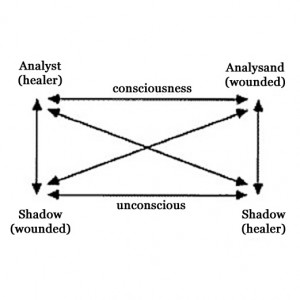The Wounded Healer archetype, as emblemized by Chiron, provides the basis for Jung’s diagram. Chiron, a centaur who suffered a profound wound that would not heal completely, served as a great healer in his own right as well as the mentor of other Greek heroes including the archetypal healer Asclepius, whose exceptional healing power was based on Chiron’s teachings. Chiron serves as the “patron saint” of Jungian analysts while Asclepius fills a similar role for physicians.
Typically, a Jungian analyst’s vocation begins in the role of analysand, his wounds serving as his conscious motivation for entering into therapy. He is consciously aware of his wounded condition; his healer function is deeply unconscious, buried in the shadow. The main work of the analysis is aimed at enabling him to become more consciously aware of his shadow and come to terms with it. In some cases, this means realizing that becoming a healer is his own authentic vocation, a true part of his individuation process.
His relationship with his analyst is based on conscious and unconscious connections. As the analysis deepens, he can “see” and experience aspects of his analyst’s shadow side. Presumably the analyst through her own analysis is sufficiently consciously aware of her own shadow, and her own wounds are healed enough, so that she does not “bleed” on her analysand; that is, she has the capacity to avoid exacting a harmful effect on her analysand or the analysis. “Above all, do no harm” applies to Jungian analysis as well as to medicine.
The analyst can see beyond her analysand’s wounds and suffering to the creative potential in his shadow. The shadow is both creative and destructive; the analyst works with the analysand (his ego position) to sort out the good from the bad.
The unconscious to unconscious link between the analyst and her analysand on occasion emerges in dreams or synchronicities. These “Aha!” experiences are a surprising realization and often create a turning point in the analysis.

